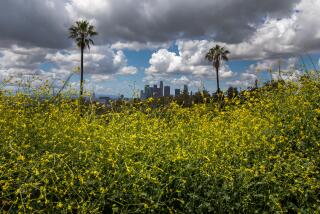Southern Blueberries Do Well in Southland : Fruit: Plants of Rabbiteye family thrive here. They need acid soil and produce good crop of delicious berries.
- Share via
You don’t usually associate blueberry plants with Southern California, but if you select the correct varieties, they will thrive in many climatic zones of the Southland.
The blueberries that grow well here are not the standard types that grow in the eastern or northern areas of the United States; standard blueberry varieties will not produce in warmer climates with mild winters such as ours.
The blueberry varieties that grow well here are members of the Rabbiteye family. Rabbiteye blueberries are native to sections of the Deep South and they will withstand hot weather and also tolerate our mild winters.
The quality of the fruit of Rabbiteye blueberries is quite good and the plants bear large quantities. Rabbiteyes not only produce delicious fruit, but the bushes, with their silver-green leaves and delicate white blossoms, are most attractive. The biggest obstacle is proper soil.
Blueberries must have an acid soil. The ideal pH range for blueberries is 4.2 to 5.2. If it goes higher than 5.5 the plants will not survive.
This presents a problem for most Southern California gardeners, as most soils in the Southland tend to be alkaline. There are two ways to overcome this. You may plant Rabbiteye blueberries in half-whiskey barrels (one plant only to each barrel) in a mixture of two-thirds acid-type peat moss and one-third commercial potting soil, or you can add one cubic foot of peat moss to each planting hole in your garden.
It is also possible to lower the pH factor by adding soil sulfur to your soil, but it’s more troublesome. I grow Rabbiteyes in half-whiskey barrels with good success.
Blueberries require an area that receives full sun. If planting in whiskey barrels, moisten the peat moss ahead of time and mix it thoroughly with the commercial soil mix. If planting directly in the garden, mix the peat thoroughly with some of the soil you have removed from the planting holes.
Set the plants 1 inch deeper than they came in the nursery container. Never add fertilizer to the soil at time of planting. This is most important, as a dose of fertilizer will kill young plants.
For the first eight weeks, if there is no rain, water the new plants twice a week. After this, when they become established, plants set in soil require water on a weekly basis. Plants in whiskey barrels will require irrigation two or three times a week. Never allow the soil to completely dry out.
A correct fertilizing program is essential. Blueberries are extremely sensitive to excessive feeding. Do not fertilize the new plants until April. Then apply a fertilizer designed for camellias and azaleas at the rate of one ounce per plant. Spread over the soil surface evenly and water in thoroughly. Do this again in June and September. Repeat for the next two years.
Then, when the plants become large and established, fertilize with one-fourth pound of camellia-azalea type fertilizer each February and the same amount after the harvest period is over.
Where do you buy Rabbiteye blueberry plants? They are sometimes available in local nurseries during bare-root season. Phone to see if your local nursery has them in stock.
Pacific Tree Farms in Chula Vista (619) 422-2400 usually carries a large stock of Rabbiteye varieties. In addition, Papaya Tree Nursery in Granada Hills (818) 363-3680 and Tropic World Nursery in Escondido (619) 746-6108 usually carry the plants.
A good mail order source for Rabbiteye plants is Finch Blueberry Nursery, P.O. Box 699, Bailey, N.C. 27807. They have a huge selection and will send a free brochure and price list.
Keep in mind that you must plant at least two different varieties for proper cross-pollination. Good varieties in our area include Woodward, Climax, Tifblue, Delite, Bluebelle and Briteblue. I grow Woodward and Climax. Again, be certain to plant at least two different varieties as most Rabbiteye blueberry varieties are not self-fruitful.
As for harvesting, Rabbiteye blueberries don’t reach flavor perfection until they have been fully colored for five or six days. Keep blueberries harvested on a weekly basis.
Rabbiteye plants will grow quite large (depending upon variety) however, they can be controlled by pruning.






